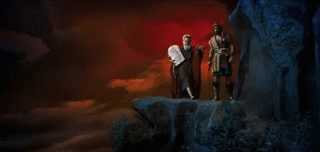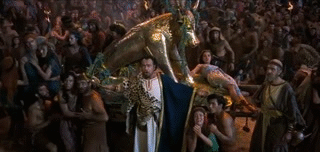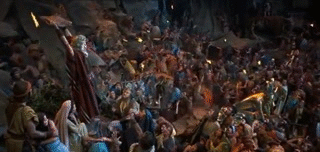So far I've been rambling about the complexities of signs but I dare to say that it was necessary to explain the cul-de-sac from which both me and my project are coming from. I already dedicated a lot of time and space to that matter (especially from a disciplinary standpoint) in the critical review from Exam 1, which might be accesed here
As a film scholar and critic I was always struggling with a discrepancy between the objects of my research and the means of their analysis. A great lineage of philosophers and scholars extending at least to Plato have dealt with the problem of epistemology in regard to images. How do they signify? How do you extract meaning from them? And most importantly - do images contribute to our knowledge?
The most common answers, upon which many academic disciplines and cultural practices arouse, were highly sceptical. In a tradition ranging from aforementioned Plato's idealism to Freud's hermeneutics of suspicion images were treated as mischievous puzzles that needed our reason (backed with concepts) to set their records straight. No wonder this approach is referred to as ICONOCLASM in visual culture. Its roots may be found in the Book of Exodus and the story of Moses that follows like this:
click on the icon















roll over the titles
Unpacking this archetypical story we might see god as knowledge, especially in relation to the story of Genesis (Adam and Eve becoming equal to god after consuming an apple from the tree of knowledge). On one hand iconoclast Moses sees his commandements as the only valid way of acquiring the hidden wisdom, on the other idolaters take their chances with an INSIGHT (knowledge gained by perceiving). The visual inquiry is not only condemned in this story, it's also ridiculed. Worshipping and consequently - making, touching and engaging are being perceived as folly and continually dismissed to the other side of spectrum within knowledge production. Therefore researching and making, thinking and feeling, images and words are being reinforced as binary oppositions.
Let's see how this reflects on my practice within film studies/film criticism and your reception of it. Suppose I am writing a paper on subliminal signals in contemporary cinematography and chose Fight Club as my case study. Few minutes ago I watched an excerpt from the film and will present you with this short analysis/description jotted down on the spot:
The scene begins with Ed Norton's narrator introducing Tyler Durden. As he speaks his first lines revealing Durden to be a night owl, we stare at a magnifying glass that slowly focuses on pictures lying beneath it. Gradually, as we get more information, what appears to be buttocks morphs into a torso and finally - a rather bulky penis. This sexual hint is reinforced in the very next shot by an image of Tyler cutting a film stock as if circumcising it. Durden's one day shadow and black rings around his eyes prove narrator's statement about his sleeping habits to be correct. America's dearest - Brad Pitt plays this film's enfant terrible against his image - together with his navy blue starry T-shirt and red trousers, it might be read as a statement about decline of American values. As characters engage in their first interaction in that scene, they visibly break the fourth wall. While Durden explains how he's pasting frames from porn films into cartoons, a so called "cigarette burn" indicating a necessity of a reel change appears on our screens. Subsequently, we move to characters' point-of-view shot of a cinema audience exposed to the subliminal tinkering of Tyler. As we move along the concentrated faces, suddenly something flashes in front of our eyes, as if one or two frames were missing. Same as with cigarette burn, also this time the diegesis of the film is being broken and Tyler's extra frame appears on our screens as well. We might conclude with narrator's own words: "I don't know if a hummingbird would catch that, but it worked".
The funny thing with the text is that regardless of what you know or don't know about this film, regardless of what is true to the image or not, this description makes sense in its own right. Even if you've never seen Fight Club and don't know who Brad Pitt is, you already have an internally coherent notion of that scene. Words usually don't need images to become meaningful, since they hinge on ideas (which in turn might be composed of multiple images as well). If all the copies of David Fincher's film spontaneously combusted during the night - this text would stay meaningful.
Saying this, I don't even remotely suggest that the text above is a valuable piece of critical analysis or that it might be superior to the film itself. On the contrary, even if it was a brilliant piece of prose and not a rushed attempt of producing valid example, it is far from being faithful to the original. Some things I didn't remember well, some things just came together for the sake of the argument, although the evidence was disputable, others are simply products of vocabulary, grammar, style and composition. Moreover, the amount of details I forgot to metion is always going to be greater than the small group of those which I described (since images are infinite within their frames). These are the problems on my part, but what about the reader? What did you see under those few chosen terms?
























roll over the boxes
What's bulky for one, might be tiny for other. Some mistakes are made due to the incompatibility of our associations, others through omission. I chose not to disclose a race of a sexual performer, I decided not to explain if american values are in decline because Tyler ended up unshaved with a low income, or because they let freaks like him deprave children with explicit porn. You don't really need to know all this stuff in order to understand the passage above, but you might require it to understand THE FILM. And film itself seemed to be the reason for this whole enterprise (called film studies, film criticism or analysis) that isn't about producing astounding belle lettres but understanding film!
Now, you take a glimpse of the scene in question and see if you agree with my statements
first click on the player
to start
second click on the player
to pause
Does it feel different now? I won't guess for everybody, because there would be as many perceptions as people watching, but I planted some controversial observations in the text on purpose. So let's see those:
1. The scene doesn't really begin with Ed Norton, it begins with Tyler. Or at least a still image of him. This might not seem that relevant, but hey, how often do you see freeze frames in mainstream cinema. This shot simply marks a beginning of series of tricks used here to break a digesis, to make you aware that you're watching a film and somebody is putting evidence in front of you.

1b. I didn't even intend 1b, but at some point in the text I mention that Tyler and Narrator break the 4th wall by pointing to cigarette burn, suggesting that it's an excess within narrative. The truth is that the whole scene is built around direct address. Norton's narrator faces us all the time and aims his speech precisely at the spectator. All the time. You don't need to break the 4th wall in this film, since it's almost non-existent. Actually, it's the moments of pure immersion and suspension of disbelief that we should be marking here.





2. Even the connection between Narrator's description of Tyler and optical enhancement of the photo under the magnifying glass, might seem to some as exaggeration, but what about this fragment:
Gradually, as we get more information, what appears to be buttocks morphs into torso and finally - a rather bulky penis.
Did you really see that?
Do you see it now?
click on the video
click on the video
Now, isn't it a little bit too much? You might wonder what is the sense of such an analysis, removed so far from our experience that we need slow motion in order to spot the difference. I can't judge this for you, but image study might have various goals, it's not always about reinforcing or explaining viewer's perception. It's often concerned with the very needs of the image that can't speak for itself and calls for discovery. Or about uncoscious viewing habits and/or characteristics of the medium. In our case, if you remember well, the study was supposed to be concerned with subliminal messages. I made my point and provided proof - it's for you to decide if it's convincing or not.
3. Before we go to the final and most important point of this little scene breakdown let's address a small lie on my part. There might be a subtle trace of facial hair on Tyler's still photo, but in the scene he is not only clean shaven
but bursting with energy. It's true that the projection room looks quite worn out and it's probably late in the night, but if Tyler really represents the decline of american values, he also represents the vitality of revolution - the fermentation of old and coming of new. I'm writing about it not because I think it's that important in case of that far too long mock-analysis, but to indicate something about description of the characters. This time it was Brad and we all know good old Brad. You could wonder if it was already a grown-up Brangelina type of Brad or a greenhorn from Johnny Suede period. You might be a little bit off, but He is a well established icon and we're more or less on the same page while discussing his role. But what if it was a newcomer - if I described him with three features only:
- one day shadow
- black rings around his eyes
- navy blue starry T-shirt and red trousers
Are we still on the same page? Do you see a rusty American god or
roll over


the box



4. Last but not least - the most important issue - subliminal penis on our screens. Our whole argument hangs on this detail, so let's see how it looks in the film
Ok, did you see the cock? There's definitely a flash of light, and its effect is visible due to the very low key of the scene (that I wrote nothing about!), but was there a penis? We could definitely HEAR pleasure, due to the moaning synchronized with the flash, but...
No, undeniably - No penis.
At least not here... as the further analysis proves
no?

